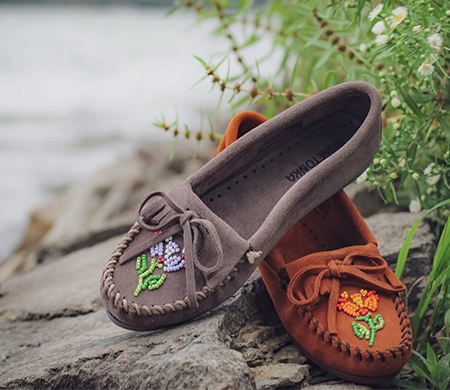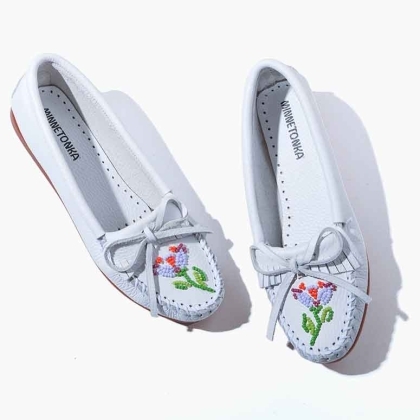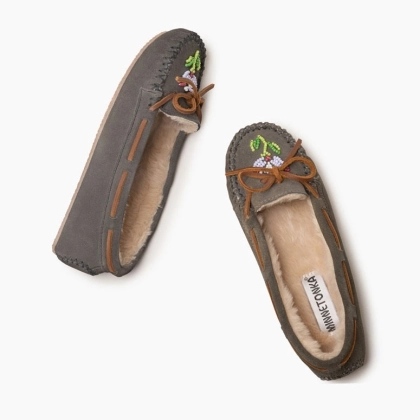The Red Lake Nation Anishinaabe designer behind Minnetonka’s first ever Indigenous beaded moc collaboration: Minnetonka x Lucie Skjefte — Ziigwan Waabigwan Design


Driven by creating space and design with an Indigenous lens, Lucie Skjefte takes pride in providing design that generates impact, invokes change and brings awareness. "It's been interesting being in this role as a graphic designer and identifying as an Indigenous designer,” says the Minneapolis-based creator, mentor and educator, when asked about what her work means to her – “producing work that surrounds design activism that is rooted in owning our truth, finding our voice, and advocating for people to be seen, acknowledged, and more importantly, heard.”
In the interview below, Lucie gives us more insight into the meaning of her work, her creative process, and the inspiration behind her design for this collection.
Please share a bit about your Native American background. Which tribe(s) do you belong to?
I’m from the Red Lake Nation located in northern Minnesota, mostly residing in Beltrami County. Red Lake resides on aboriginal land, since the Dakota moved from the region in the mid-1700’s. We are a Sovereign Nation composed of four reservation communities; Little Rock, Ponemah, Redby, and Red Lake.
How did you get into graphic design?
I've been a graphic designer for 10 years now. I’ve always been intrigued by design and the arts, and naturally a creative and artistic person. I started studying graphic design in college after learning that a computer science degree wasn’t for me. I had already completed the bulk of my generals, and once I shifted into graphic design I became fully immersed in the program and discovered that my natural abilities would shine in this field. I have since pushed myself to continue to grow and develop my skill sets further.
How would you describe the type of art/graphic design you do?
I’ve often described myself as a 2-dimensional designer because my work tends to be that, sometimes composed of a mixture of media. My work is also rooted in design activism that challenges the status quo with positivity.
Can you describe your creative process? Where do you find inspiration?
I love to create when that vision hits me – as soon as I can see it, and once I can sense the steps and strokes I’d take to create it, it’s just implementation after that. Each design begins with inspiration and ideation, followed by concept creation and iteration of sketching, then developing a color palette structure.
I find a lot of inspiration through researching my culture’s history and design in historical archives. I’m also observational in paying attention to all my senses – whether that is by look, touch, or feel. I’m always inspired by conversations with others, and the simplicity of shapes and forms that surround me.


What’s your favorite thing about being a designer? How do you feel while you’re creating your designs?
One of my favorite things is having the ability to innately think creatively around the complexity of solving problems and providing creative solutions – not just in design, but in basic troubleshooting in life in general. I also love the impact of the designs that I’ve produced and the happiness that it brings to people – how proud they are to wear or carry that design, logo or graphic in whatever form that it was given to them. That sense of pride is everything.
Design is Medicine. It’s given this life of mine purpose and has shown me how I can continue to contribute and show up in my community. I like that I can channel my creativity and transcend this gift of knowledge and discipline within the work I produce, and that I always have the opportunity to continue to grow and to teach.


Can you describe the symbolism behind your design for this shoe collection?
Ziigwan Waabigwan (pronounced: Zeeg-one Waah-big-one) translates to “Spring Flower” in Ojibwemowin, the language of the Anishinaabe people. For this collection, I used a tulip floral design that is commonly found in woodland floral design, streamlined to its simplest form. I chose colors that were fun, different, and less literal in translation from our traditional understanding of these designs for an upbeat and playful feel.
What made you want to collaborate with Minnetonka?
This collaboration was motivated by Adrienne Benjamin for sure! I trusted in her the same way she trusts in me to bring Anishinaabeg designs to the forefront of the work. My hope is that this collaboration shines light and positivity in a way that pays homage and respect to our way of life and our people.
This is for our gookomisinaan (Grandmothers). The moment that I closed my eyes and envisioned seeing our grandmothers buying these moccasins for their grandchildren and proudly hitting the pow wow trail with them knowing that they were designed by an Anishinaabekwe; that thought made my heart so happy. I decided that this collaboration with Minnetonka also made me feel a sense of empowerment in creating makinzinan that will resonate with and inspire our grandmothers, anties (we call our aunties – anties), sisters, and nieces. This is for them.


How do you want people to feel while wearing your designs?
I want them to feel proud – to have a sense of pride in the accessibility to moccasins with beading that was designed by an Indigenous designer. I’m humbled and gracious to be able to do this work for my community in a way that shines love, light, and positivity for Anishinaabeg – and the rest of the Indigenous community at large! I do this work because we’re still here, and it's important to give time and space to showcase that. This work is a gift to us, to our grandmothers, anties, nieces, and any one person that is honored to wear them, and more importantly, for our future generations to continue to learn and be inspired!
To learn more about Minnetonka’s commitment to the Native American community, please visit this link.
To learn more about Lucie Skjefte, please visit her website.





